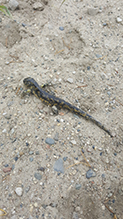Eastern tiger salamander
(Ambystoma tigrinum)
Conservation • Description • Habitat • Ecology • Distribution • Taxonomy
Conservation Status |
|||
| IUCN Red List | LC - Least Concern |
||
| NatureServe | N5 - Secure S5 - Secure |
||
| Minnesota | not listed |
||
Description |
Eastern tiger salamander is a large, terrestrial, mole salamander. It is the largest terrestrial salamander in Minnesota. Only the mudpuppy (Necturus maculosus), an aquatic salamander, is larger. Adults are usually 6¾″ to 8⅝″ in length but they can be much larger. In 1994 one was found in Minnesota that was 13¾″ long. Males tend to be larger than females. The body is stout with four well-developed limbs that project sidewards. The trunk is cylindrical. There are 11 to 14 prominent vertical depressions (costal grooves) between the forelimbs and the ventral area. The skin is soft, moist, and black with dull yellow, irregularly sized and spaced blotches. The belly is black with yellow splotches. The color pattern is highly variable and may be geographically distinct. Juveniles are mostly black with small yellow spots. As the salamander ages, the spots usually become larger and fuse together, increasingly obscuring the black background. The tail is long and tapered. The head is large, short and wide with a broad, rounded snout. The lower lip and throat are usually yellow. The eyes are small, round, and protruding. The legs are short and stout, with broad feet. The hind legs have five toes. The fore legs have four toes. The toes are short, broad at the base, and tapered to the tip. The larvae have a paler background color, dark splotches, dark lateral stripes, and a whitish belly. They have long, filamentous, external gills and a wide tail fin (caudal fin) that extends from just behind the head on the upper side to the ventral area on the underside, wrapping around the tail. |
Size |
6¾″ to 8⅝″ |
Similar Species |
Spotted salamander (Ambystoma maculatum) background color is gray. The spots are more regularly rounded and occur in two irregular rows. The spots on the head may be orange. The belly is gray with no spots. It has been recorded only in Pine and Carlton Counties. |
Habitat |
Prairies, agricultural fields, woodlands, and residential areas, all near permanent or semi-permanent bodies of water. |
Ecology |
Behavior |
Eastern tiger salamander, like all salamanders, is rarely encountered. It spends the day in a burrow, usually one that it has dug itself, sometimes in one dug by rodent, shrew, or other animal. The burrow may be up to 40″ deep. The salamander comes out at night to feed. It is sometimes encountered by humans in window wells and damp basements. It is sometimes seen aboveground at night during and after a rainfall, moving to or from a breeding pond, during the spring breeding and migration season. The skin exudes a milky, unpleasant tasting liquid in response to a predator. |
Lifespan |
16 years |
Life Cycle |
Breeding takes place in the early spring, often before the ice has cleared from the surface of the pond. Adults migrate up to about 330 yards to a pond or other suitable body of water. To initiate breeding, the male will nudge a female to separate it from other salamanders. It then deposits a sperm capsule on the pond bottom, the female picks up the sperm capsule, and the process is repeated. At night, usually 24 to 48 hours after fertilization, the female lays fragile masses of up to 100 eggs and attaches them to twigs, grass stems, and decayed leaves on the bottom of the pond. She may lay up to 1,000 eggs. The eggs hatch in 2 to 5 weeks, depending on the temperature. Larvae may metamorphose into sexually mature adults in their first or second summer, or they may become sexually mature without metamorphosis. Adults overwinter in burrows or under logs or other debris. Their lifespan is about 16 years in the wild, up to 25 years in captivity. |
Tadpole Food |
Small crustaceans and insect larvae, when young; also other salamander and small fish when older. Some are also cannibalistic, feeding on other salamander larvae. |
Adult Food |
Earthworms, insects, snails, and slugs, and any other small animal that can be captured and swallowed. |
Distribution |
||
|
Sources 6, 7, 14, 24, 29, 30, 73, 76, 78. Biodiversity occurrence data published by: Minnesota Biodiversity Atlas (accessed through the Minnesota Biodiversity Atlas Portal, bellatlas.umn.edu, XX/XX/XXXX). |
|
| 9/5/2025 | ||
Occurrence |
||
Common and widespread |
||
Taxonomy |
|
Class |
Amphibia (amphibians) |
Superorder |
Batrachia (frogs and salamanders) |
Order |
Caudata (salamanders) |
Suborder |
Salamandroidea (mole salamanders) |
Family |
Ambystomatidae (mole salamanders) |
Genus |
Ambystoma (mole salamanders) |
There is disagreement among taxonomists about the use of the names Caudata and Urodela. The crown group includes the extant (still living) species, the most recent common ancestor of the extant species, and all descendants of that ancestor. The pan group or total group is the crown group plus all extant organisms most closely related to it. Some taxonomists use Caudata for the crown group and Urodela for the pan group. Most use Urodela for the crown group and Caudata for the pan group. That is the ranking followed here. |
|
Subordinate Taxa |
|
Until recently, there were eight subspecies recognized. Three were raised to full species; California tiger salamander (Ambystoma californiense); barred tiger slamander (Ambystoma mavortium); and plateau tiger salamander (Ambystoma velasci). Five others were placed as subspecies of barred tiger slamander: Arizona tiger salamander (A. m. nebulosum), barred tiger salamander (A. m. mavortium); blotched tiger salamander (A. m. melanostictum); gray tiger salamander (A. m. diaboli); and Sonoran tiger salamander (A. m. stebbinsi). There are currently no recognized subspecies of eastern tiger salamander (Ambystoma tigrinum). |
|
Synonyms |
|
Ambistoma tigrinum Amblystoma bicolor Amblystoma copeianum Amblystoma obscurum Amblystoma tigrinum Amblystoma xiphias Ambystoma bicolor Ambystoma conspersum Ambystoma episcopus Ambystoma ingens Ambystoma lurida Ambystoma sopeanum Ambystoma tigrinum ssp. tigrinum Axolotus philadelphicus Heterotriton ingens Proteus neocaesariensis Salamandra ingens Salamandra lurida Salamandra tigrina Siredon harlanii Siren operculata Triton ingens Triton tigrinus |
|
Common Names |
|
eastern tiger salamander tiger salamander |
|
Glossary
Costal groove
On salamanders: vertical grooves along the side of a salamander between the forelegs and the groin, each corresponding to the space between ribs, that aid in keeping the skin moist by transporting water over the surface of the body.
Visitor Photos
Share your photo of this amphibian.
This button not working for you?
Simply email us at info@MinnesotaSeasons.com.
Attach one or more photos and, if you like, a caption.
Melanie Hilgendorf |
||
Saw crossing the road 1 mile NE of Owatonna, MN |
||
 |
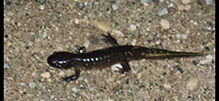 |
|
|
||
Molly and Robert Power |
||
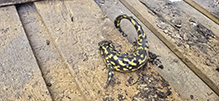 |
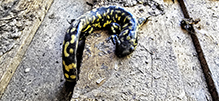 |
|
Found near the chicken coop! |
||
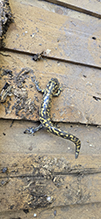 |
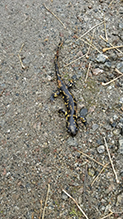 |
|
|
Not sure what type of salamander this is, but we were surprised to see it crossing our driveway! |
|
Lisa Schmidt |
 |
Nobles County |
Luciearl |
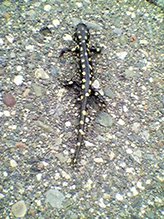 |
Stopped to help this little one cross a busy road. |
Anna |
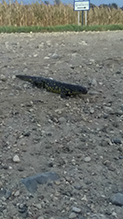 |
Found this cutie walking on the gravel road outside of sleepy eye! |
Julie |
||
Not sure if this is a tiger salamander. Found it walking across a dirt road late morning. |
||
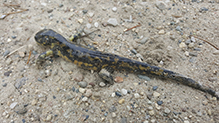 |
||
Bill Reynolds |
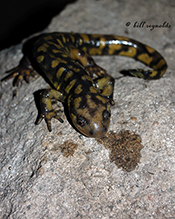 |
MinnesotaSeasons.com Photos
|

Slideshows
Ambystoma tigrinum (Tiger Salamander)
Allen Chartier
Ambystoma tigrinum (Eastern Tiger Salamander)
John Clare

Visitor Videos
Share your video of this amphibian.
This button not working for you?
Simply email us at info@MinnesotaSeasons.com.
Attach a video, a YouTube link, or a cloud storage link.
Other Videos
Eastern Tiger Salamander (Ambystomatidae: Ambystoma tigrinum tigrinum) with Excavation
Carl Barrentine
Tiger Salamander Larva (Ambystomatidae: Ambystoma tigrinum) Close-up
Carl Barrentine

Visitor Sightings
Report a sighting of this amphibian.
This button not working for you?
Simply email us at info@MinnesotaSeasons.com.
Be sure to include a location.
Melanie Hilgendorf
9/4/2025
Location: Havana Township, Steele County
Saw crossing the road 1 mile NE of Owatonna, MN
Amy
9/29/2023
Location: South Haven, Minnesota, Wright County
Saw a couple of these and thinking it is getting ready to hibernate. Thank you rain and humidity for bringing these cool creatures out.
Anna
9/25/2019
Location: Sleepy Eye, Minnesota
Found this cutie walking on the gravel road outside of sleepy eye!
Pelon
9/10/2019
Location: Garfield, Mn
Every year seems to meet one around this area...fun to watch with kidoz...
Julie
10/19/2018
Location: Wadena County
Not sure if this is a tiger salamander. Found it walking across a dirt road late morning.
JoDawn
8/17/2017
Location: Cass County, MN
Found in a fold of black plastic that I had spread on my garden area. Moved it to a marshy area a few hundred feet from where I found it. Approximately 6" long. Did not get photo.
MinnesotaSeasons.com Sightings


